Geological engineering is a diverse and interdisciplinary field that encompasses various branches, each focusing on different aspects of the Earth’s geology and its interaction with human activities. These branches aim to apply geological principles and techniques to solve engineering problems and mitigate geological hazards.
Geotechnical Engineering
Geotechnical engineering encompasses various subtopics, including soil and rock mechanics, design and construction of foundations, slope stability analysis, slope stability and landslides, and rock mechanics and tunneling. Soil and rock mechanics involve studying the behavior and properties of soils and rocks, providing insights into their strength, stability, and deformation characteristics. The design and construction of foundations focus on creating stable structures by considering soil properties and load requirements. Slope stability analysis evaluates the stability of slopes and helps prevent landslides. Lastly, rock mechanics and tunneling explore the behavior and design of tunnels in rock formations, ensuring their stability and safety.
Soil and Rock Mechanics
Soil and rock mechanics play a crucial role in geotechnical engineering. Understanding the behavior of soil and rock materials is essential for designing and constructing safe and sustainable structures. Soil mechanics is the study of the mechanical properties and behavior of soil, including its strength, stiffness, and deformation characteristics. It involves analyzing the stress-strain relationships, consolidation, and shear strength of soils. This knowledge is vital for designing foundations that can support the loads imposed by structures and prevent settlements.
On the other hand, rock mechanics focuses on the behavior of rocks, including their strength, deformation, and stability. It is particularly important in tunneling and underground excavations, where the stability of the rock mass is crucial for the safety of the workers and the structure itself.
The principles of soil and rock mechanics are applied in various geotechnical engineering projects, such as the design of foundations for buildings, bridges, and other structures, as well as the analysis of slope stability and landslide mitigation.
Design and Construction of Foundations
The design and construction of foundations is a critical aspect of geotechnical engineering. Foundations provide support and stability to structures, ensuring their long-term durability and safety. The design process involves analyzing the soil and rock mechanics to determine the appropriate type and size of foundation required for a particular structure. Factors such as the soil’s bearing capacity, settlement characteristics, and groundwater conditions are considered to ensure the foundation can effectively distribute the structure’s load.
One commonly used type of foundation is the shallow foundation, which is designed to transfer the load to a relatively shallow depth. Examples of shallow foundations include spread footings, mat foundations, and slab-on-grade foundations. These foundations are typically used for low-rise structures and can be cost-effective and straightforward to construct.
On the other hand, deep foundations are used when the soil near the surface is unable to support the load. Deep foundations, such as pile foundations and drilled shafts, are designed to transfer the load to deeper, more competent soil or rock layers.
Slope Stability Analysis
Slope stability analysis is a critical component of geotechnical engineering as it focuses on assessing the stability of slopes and preventing landslides. This analysis is crucial in determining the safety and feasibility of constructing infrastructure such as highways, dams, and buildings on sloping terrain.
The analysis involves evaluating the factors that influence slope stability, including the properties of the soil or rock, the slope geometry, and external forces such as rainfall or earthquakes. Engineers use various methods to conduct slope stability analysis, including limit equilibrium methods, finite element analysis, and numerical modeling.
One commonly used method is the limit equilibrium method, which assumes that the slope is in equilibrium when it is on the verge of failure. By considering the forces acting on the slope and applying appropriate equilibrium conditions, engineers can determine the factor of safety, which indicates the margin of safety against slope failure.
Finite element analysis involves dividing the slope into small elements and analyzing the behavior of each element under different loading conditions.
Environmental Geology
Environmental geology encompasses several subtopics that are essential for understanding and managing our environment. Hydrogeology involves studying the movement and distribution of groundwater, which is crucial for managing water resources and identifying potential sources of contamination. Environmental Impact Assessments play a vital role in identifying and mitigating the environmental consequences of development projects. Contamination Assessment and Remediation focuses on identifying and cleaning up polluted sites, ensuring the protection of human health and the environment. Geological mapping for environmental planning and management helps in identifying areas prone to geological hazards such as earthquakes, allowing for informed decision-making and hazard mitigation measures.
Hydrogeology

In addition to its applications in geotechnical engineering, the field of geology also plays a crucial role in various aspects of environmental management and planning. One important area where geology intersects with the environment is hydrogeology. Hydrogeology is the study of groundwater, its movement, and its interaction with geological formations.
Understanding the behavior of groundwater is essential for a range of environmental issues. For example, hydrogeological studies help in assessing the sustainability of water resources and ensuring their long-term availability. These studies provide valuable insights into the recharge and discharge of aquifers, allowing for effective management of water supply.
Moreover, hydrogeology is instrumental in addressing the challenges associated with groundwater contamination. By investigating the movement and flow of pollutants through the subsurface, experts can better assess the extent and severity of contamination. This knowledge forms the basis for environmental impact assessments and subsequent remediation strategies.
Environmental Impact Assessments
Environmental Impact Assessments (EIA) play a crucial role in determining the potential environmental consequences of proposed development projects. These assessments are conducted to identify, predict, and evaluate the potential impacts on the environment and human health. EIA provides a systematic framework for decision-making by considering various factors such as air quality, water resources, land use, and ecological systems.
One of the key objectives of EIA is to ensure that development projects are designed and implemented in a sustainable manner, minimizing negative impacts and maximizing positive ones. It involves a comprehensive analysis of the project’s potential effects on the environment, including both short-term and long-term impacts. The assessment includes the identification of potential risks and the development of mitigation measures to minimize or eliminate adverse effects.
In recent years, there has been an increased emphasis on incorporating EIA into the decision-making process for all types of development projects. This is driven by the recognition of the importance of sustainable development and the need to protect and preserve the environment for future generations.
Contamination Assessment and Remediation
Contamination Assessment and Remediation is a crucial aspect of environmental geology that focuses on identifying and mitigating the impact of pollutants on the environment. With the growing concern over pollution and its detrimental effects on ecosystems and human health, the need for effective assessment and remediation strategies has become increasingly important.
Contamination assessment involves the identification and characterization of pollutants in soil, water, and air. Various techniques such as sampling, testing, and monitoring are employed to determine the extent and nature of contamination. These assessments provide valuable information for designing appropriate remediation strategies.
Remediation aims to remove or reduce the concentration of pollutants to levels that are safe for humans and the environment. There are several remediation techniques available, including pump-and-treat, bioremediation, chemical oxidation, and thermal treatment. The selection of the most suitable technique depends on factors such as the type of contamination, site conditions, and cost-effectiveness.
Geophysics
Seismology is a branch of geophysics that studies earthquakes and the propagation of elastic waves through the Earth. It provides insights into the Earth’s internal structure and composition. Exploration geophysics focuses on applying geophysical methods to explore natural resources such as oil, gas, and minerals. Techniques like seismic imaging are used to create detailed images of the subsurface, providing valuable information for resource exploration. Geophysical data processing plays a crucial role in analyzing and interpreting data collected through various geophysical methods.
Seismology
Seismology is a branch of geophysics that studies earthquakes and the propagation of seismic waves through the Earth. It plays a crucial role in understanding the Earth’s internal structure and the processes that occur within it. Seismic waves, generated by earthquakes or artificial sources, provide valuable information about the subsurface layers of the Earth.
One of the main applications of seismology is in exploration geophysics, where it is used to locate and map subsurface structures that may contain valuable resources such as oil, gas, or minerals. By analyzing the characteristics of seismic waves, geophysicists can determine the location and properties of subsurface rock formations.
Seismic data acquired during exploration campaigns are processed and analyzed using advanced geophysical data processing techniques. These techniques involve the application of various mathematical algorithms to enhance the quality of the seismic data and extract meaningful information from it.
Seismology also plays a vital role in the development of exploration techniques.
Exploration Geophysics
Seismology, a branch of geophysics, plays a crucial role in understanding the Earth’s interior structure and seismic activities. By studying the propagation of seismic waves, seismologists gain valuable insights into the composition, density, and temperature of the Earth’s layers. They use seismic data to locate and analyze earthquakes, determine the magnitude and focal depth, and assess the associated risks.
Exploration geophysics employs a variety of techniques to study subsurface structures and resources. It aims to identify potential mineral deposits, hydrocarbon reservoirs, and groundwater sources. Geophysical methods such as gravity, magnetic, electromagnetic, and resistivity surveys are used to measure the physical properties of the subsurface. These surveys provide valuable information about the distribution of rocks, minerals, and fluids, helping to guide exploration efforts.
Geophysical data processing is an essential step in the exploration. It involves the manipulation, analysis, and interpretation of geophysical data to extract meaningful information.
Geophysical Data Processing

Seismology, Exploration Geophysics, Geophysical Data Processing, exploration techniques, and seismic imaging are all integral components of geophysics, a field that focuses on studying the Earth’s physical properties using various methods. Geophysical data processing is a crucial step in this process, as it involves transforming raw data collected from seismic surveys into meaningful and interpretable information.
During geophysical data processing, several techniques are employed to enhance the quality of the data. These techniques include data filtering, noise reduction, and deconvolution, among others. The primary goal is to remove unwanted noise and improve the signal-to-noise ratio, resulting in clearer and more accurate images of subsurface geological structures.
One of the key challenges in geophysical data processing is dealing with the vast amounts of data generated during exploration surveys. To address this, advanced computer algorithms and high-performance computing systems are utilized to process and analyze the data efficiently.
The processed data is then used in seismic imaging, which involves creating detailed images of the subsurface.
Mining Engineering
Mining engineering is a multifaceted field that encompasses various subtopics and areas of expertise. Mine design and planning involves determining the layout and infrastructure of a mine, ensuring optimal efficiency and safety. Mining methods and equipment focus on selecting the most appropriate techniques and machinery for extracting minerals from the earth. Mine ventilation and safety are crucial for maintaining a safe working environment by controlling air quality, and temperature, and removing hazardous gases. Exploration and feasibility studies play a vital role in assessing the viability of potential mining sites. Lastly, mine planning and design involve creating strategic plans for the long-term development and sustainability of a mine.
Mine Design and Planning
Mine Design and Planning plays a crucial role in the field of Mining Engineering, as it involves the systematic arrangement and layout of mining operations to maximize efficiency and productivity while minimizing costs and environmental impact. Effective mine design and planning requires a comprehensive understanding of geological conditions, ore characteristics, and operational requirements.
Geological data such as rock type, structure, and mineralization are analyzed to determine the most suitable mining method and equipment for extracting the ore. This information is then used to create a detailed mine plan that includes the location of access roads, ramps, tunnels, and other infrastructure necessary for efficient operation.
Advanced technologies such as computer-aided design (CAD) and mine planning software are utilized to optimize the design, taking into account factors such as slope stability, waste disposal, and ventilation requirements. Safety considerations are also integrated into the design to ensure the well-being of mine workers.
Mining Methods and Equipment
With the increasing demand for minerals and metals worldwide, the mining industry has become a crucial component of modern society. Mining Methods and Equipment play a vital role in the efficient and safe extraction of valuable resources from the earth. These methods and equipment are carefully selected and designed to optimize productivity while minimizing environmental impact and ensuring the safety of workers.
In mining engineering, the selection of mining methods is based on several factors, including the type and depth of the deposit, the geotechnical characteristics of the rock mass, and the economic feasibility of the operation. Common mining methods include open-pit mining, underground mining, and placer mining. Each method has its advantages and limitations, and the choice depends on various factors.
When it comes to mining equipment, technological advancements have revolutionized the industry. From the early days of manual labor to the modern era of automated machinery, mining equipment has evolved to enhance efficiency and productivity. Equipment such as excavators, haul trucks, and drills are used for various tasks, including drilling, blasting, loading, and hauling.
Mine Ventilation and Safety
Geophysics is an essential field within the study of Earth’s structure and processes. It provides valuable information for various applications, including Mining Engineering. In the field of Mining Engineering, Mine Ventilation, and Safety plays a crucial role in ensuring a safe and healthy working environment for miners.
Mine ventilation involves the circulation of fresh air into underground mines while removing hazardous gases and dust. This process is necessary to maintain a safe oxygen level and to prevent the accumulation of harmful substances. Ventilation systems typically consist of fans, ducts, and airways that direct the flow of air throughout the mine.
Safety is of utmost importance in mining operations, as the industry is inherently hazardous. Various safety measures are implemented to prevent accidents and protect workers. These measures include the use of personal protective equipment, regular safety training, and the enforcement of strict safety regulations.
To ensure the effectiveness of ventilation systems and safety protocols, mining engineers employ advanced technologies such as computer simulations and monitoring devices.
Structural Geology
Structural geology is a subfield of geology that focuses on the study of geological structures and their formation processes. Stress and strain analysis plays a crucial role in understanding the behavior of rocks under different conditions. By analyzing stress distribution, scientists can determine the likelihood of rock fracturing and predict potential hazards such as earthquakes. Rock fracture mechanics further investigates the mechanics of rock failure, providing insights into the strength and stability of geological formations. Geological structures and maps help to visualize and interpret the complex deformation patterns of rocks, aiding in the identification and characterization of geological features. Stress analysis and structural geology mapping are essential tools for understanding the evolution of Earth’s crust.
Stress and Strain Analysis
Stress and Strain Analysis is a fundamental aspect of Structural Geology. This field focuses on understanding the deformation and behavior of rocks under stress. By analyzing stress and strain, geologists can gain valuable insights into the tectonic forces that shape the Earth’s crust.
In stress analysis, geologists study the distribution and magnitude of forces acting on rocks. They use techniques such as finite element analysis and Mohr circles to determine the stress state at different locations. This analysis helps in identifying areas of high-stress concentration, which can have implications for engineering projects or natural hazards.
Strain analysis, on the other hand, involves measuring the deformation of rocks in response to stress. Geologists use tools like strain gauges and strain markers to quantify the changes in rock shape and size. By understanding the patterns of strain, geologists can reconstruct the history of deformation in a region.
Stress and strain analysis are crucial for structural geology mapping.
Rock Fracture Mechanics
Rock Fracture Mechanics plays a pivotal role in the field of Mining Engineering. It is the study of how rocks break and deform under the influence of stress. Understanding rock fracture mechanics is crucial for various mining operations, as it helps in predicting rock failures, designing support systems, and ensuring the safety of mine workers.
Rock fracture mechanics involves analyzing the behavior of rocks subjected to different types of stress, such as compression, tension, and shear. By studying the mechanics of rocks, engineers can assess the stability of rock masses and determine the likelihood of fractures occurring.
One important aspect of rock fracture mechanics is the determination of fracture toughness, which measures a rock’s resistance to crack propagation. This parameter is essential for designing support systems in underground mines and preventing catastrophic failures.
Furthermore, rock fracture mechanics is utilized in the development of advanced mining techniques such as hydraulic fracturing, which involves creating fractures in the rock formation to enhance the extraction of resources. By understanding how rocks fracture and deform, engineers can optimize these techniques to maximize resource recovery.
Geological Structures and Maps
Geological Structures and Maps play a crucial role in understanding the Earth’s subsurface and its potential for various applications such as resource exploration, hazard assessment, and engineering design. By analyzing and interpreting geological structures and mapping them, geologists and engineers can gain valuable insights into the behavior of rocks and the stresses they experience. Structural geology mapping involves the systematic collection of data on the distribution, orientation, and geometrical relationships of geological features, such as faults, folds, and joints. This information is then used to construct accurate geological maps that provide an overview of the subsurface structures.
Stress analysis is an essential component of structural geology, as it helps determine the forces acting on rocks and the resulting deformation. By analyzing the stresses and strains within the Earth’s crust, geologists can understand the processes that have shaped the landscape and predict how rocks may respond to future forces. Rock Fracture Mechanics is another important aspect of geological structures, focusing on the study of how rocks break and fracture under stress.
Petroleum Engineering
Petroleum Engineering is a multidisciplinary field that encompasses various subtopics such as Reservoir Engineering, Drilling Technology, Production Technology, Petrophysics, and Well testing. Reservoir Engineering focuses on the characterization and management of subsurface reservoirs to optimize hydrocarbon recovery. Drilling Technology involves the design and implementation of drilling techniques and equipment to efficiently and safely extract oil and gas from the ground. Production Technology deals with the optimization of production processes to maximize output. Petrophysics is the study of rock and fluid properties to better understand reservoir behavior.
Reservoir Engineering
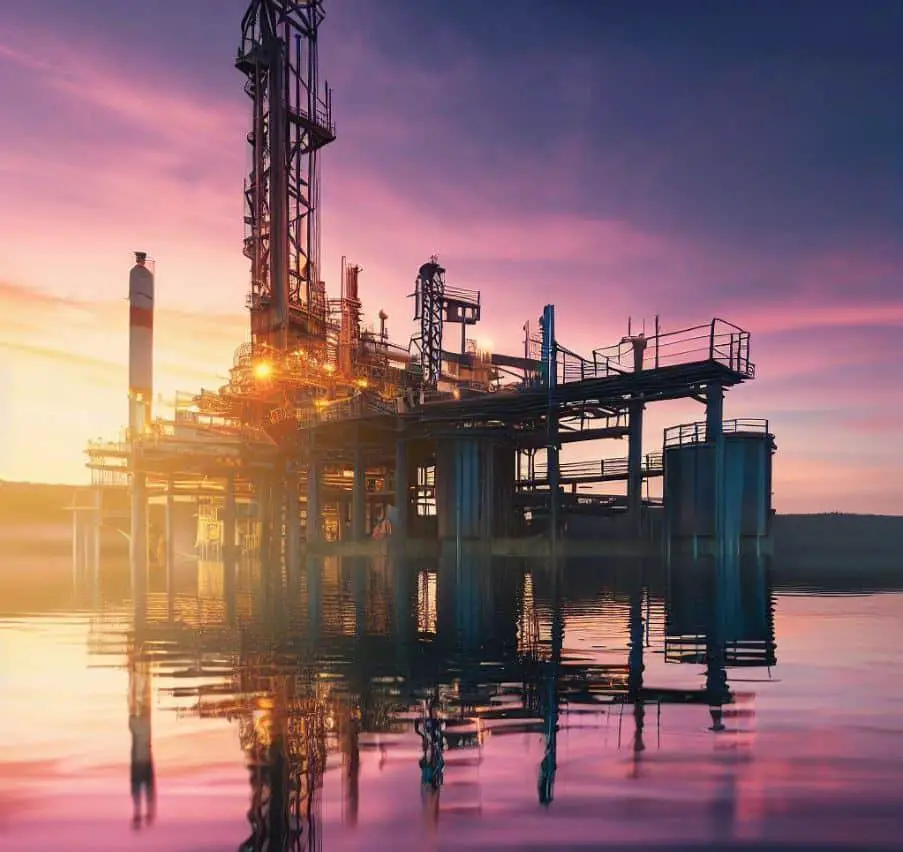
Now that we have explored the fundamental concepts of structural geology, let us delve into the world of petroleum engineering.
Reservoir engineering is a crucial aspect of petroleum engineering that focuses on the characterization and management of underground reservoirs. Its primary goal is to maximize the production of hydrocarbons and optimize the economic viability of the reservoir. Reservoir engineers employ various techniques to achieve this, including reservoir simulation, well testing, and fluid flow analysis.
Reservoir engineers utilize advanced software and mathematical models to simulate the behavior of reservoirs under different production scenarios. These simulations provide valuable insights into the reservoir’s properties, such as porosity, permeability, and fluid saturation. By understanding these characteristics, engineers can determine the optimal drilling and production strategies.
Furthermore, reservoir engineers play a critical role in estimating the reserves and predicting the future production potential of a reservoir. They analyze historical data, well logs, and core samples to develop accurate reservoir models. This information is essential for making informed decisions regarding reservoir development, such as well placement and production rates.
Drilling Technology
To fully harness the potential of petroleum reservoirs, drilling technology plays a crucial role in the overall success of petroleum engineering. The process of drilling a well involves creating a borehole in the earth’s subsurface that allows for the extraction of oil and gas resources. This complex process requires advanced techniques and equipment to ensure safe and efficient operations.
Drilling technology has evolved significantly over the years, driven by advancements in engineering and technology. It involves utilizing various drilling techniques such as rotary drilling, directional drilling, and horizontal drilling to reach the target reservoirs. Additionally, advanced drilling tools and equipment such as drill bits, drilling muds, and downhole drilling motors are employed to enhance drilling efficiency and accuracy.
In recent years, the industry has witnessed the development of automated drilling systems that utilize artificial intelligence and machine learning algorithms to optimize drilling operations. These systems enable real-time monitoring and control, reducing human error and improving drilling performance.
Furthermore, wellbore stability is a critical aspect of drilling technology.
Production Technology
In order to efficiently extract oil and gas from reservoirs, the field of Production Technology plays a crucial role. Production Technology focuses on the design and implementation of techniques and processes to optimize the production of hydrocarbons from wells. This encompasses a wide range of activities, including well completion, artificial lift systems, and production monitoring.
Well completion involves the installation of equipment and materials in a well to ensure its integrity and enable efficient production. This includes casing and cementing operations to protect the wellbore and prevent fluid migration. Additionally, artificial lift systems are employed to enhance the flow of hydrocarbons from the reservoir to the surface. Techniques such as rod pumps, electrical submersible pumps, and gas lift systems are utilized to overcome the natural decline in reservoir pressure.
Production monitoring is another key aspect of Production Technology. It involves the continuous surveillance of well performance through various methods such as downhole gauges, surface sensors, and real-time data analysis. This enables operators to identify potential production issues and optimize production strategies.
Coastal Engineering
Coastal engineering encompasses various subtopics, including coastal processes and hazards, which focus on understanding and mitigating the impact of natural forces on coastlines. This involves studying wave and current dynamics, erosion, and sediment transport. Coastal structures and design are crucial in protecting coastal areas from erosion and sea-level rise. Examples of such structures include seawalls, breakwaters, and groins. Coastal morphology and modeling involve assessing and predicting changes in coastal landforms and sediment distribution. Coastal flood protection aims to minimize the risk of flooding through measures like dikes and flood barriers.
Coastal Processes and Hazards
Coastal processes and hazards play a significant role in shaping the dynamic nature of coastal environments. Understanding these processes is essential for effective coastal management and planning.
Wave action is one of the primary coastal processes that influence coastlines. Waves, driven by wind, can erode and transport sediments along the coast, leading to changes in shoreline position. The intensity and frequency of storms can also cause significant coastal erosion and flooding, posing hazards to coastal communities.
Tidal forces, generated by the gravitational pull of the moon and sun, also impact coastal areas. Tides can cause fluctuations in water levels, affecting sediment transport and erosion rates. Additionally, tidal currents can shape the morphology of coastal features, such as sandbars and tidal inlets.
Coastal storms are another hazard that can have severe impacts on coastal regions. Storm surges, accompanied by high winds and intense rainfall, can result in coastal flooding, erosion, and infrastructure damage.
Coastal Structures and Design
Coastal structures are vital components of coastal engineering, providing protection against coastal hazards and facilitating coastal development. These structures are designed to withstand the forces of waves, tides, and currents while minimizing the impact on the environment. The design process involves a comprehensive understanding of coastal processes and a careful consideration of various factors, such as wave characteristics, sediment transport, and shoreline stability.
One commonly used coastal structure is the seawall, which is typically made of concrete or steel and is constructed parallel to the shoreline. Seawalls are designed to absorb wave energy and protect coastal communities from erosion and flooding. However, they can also cause unintended consequences, such as increased erosion in adjacent areas and loss of beach access.
Another important coastal structure is the breakwater, which is built offshore to reduce the energy of incoming waves. Breakwaters create calmer water conditions near the shore, making it safer for navigation and beach activities.
Coastal Morphology and Modelling

Coastal morphology refers to the study of the physical features and processes that shape the coastlines. Understanding coastal morphology is crucial for coastal engineering and management as it provides insights into the natural evolution of coastal systems and how they respond to various forces.
Coastal modeling plays a significant role in predicting and analyzing coastal morphology. It involves the use of mathematical models and computer simulations to simulate coastal processes and predict how they will shape the coastline over time. These models consider factors such as wave action, sediment transport, and shoreline changes to provide valuable information for coastal planning and design.
One commonly used model in coastal morphology is the shoreline evolution model. This model simulates the long-term behavior of shorelines by considering factors such as wave climate, sediment characteristics, and sea-level rise. By inputting these parameters, engineers can predict how a coastline will change and identify areas that may be more vulnerable to erosion or flooding.
Rock Mechanics
Rock Mechanics is a branch of geotechnical engineering that focuses on the behavior of rocks under various conditions. Rock Mass Characterization involves the assessment of rock properties, such as strength, deformation, and weathering, to determine its suitability for engineering projects. Rock Strength Testing aims to determine the rock’s ability to resist external forces, providing essential data for construction and design. Stress Measurement and Analysis focuses on measuring and analyzing stress distribution within rocks, crucial for understanding their stability. Rock slope stability analysis and design involves evaluating the stability of rock slopes and designing measures to prevent failures.
Rock Mass Characterization
To effectively analyze and design rock engineering projects, it is crucial to understand the characteristics of the rock mass in question. Rock Mass Characterization plays a fundamental role in assessing the behavior of rock materials and determining their suitability for various engineering applications. This process involves evaluating the physical, mechanical, and geological properties of the rock mass.
One commonly used method for rock mass characterization is the Rock Quality Designation (RQD). RQD is determined by measuring the percentage of intact and sound rock pieces larger than 100 mm in drilled core samples. This metric provides an indication of the degree of jointing and fracturing within the rock mass and can help assess its overall strength and stability.
Another important aspect of rock mass characterization is the identification of discontinuities, such as bedding planes, joints, faults, and shear zones. These discontinuities significantly influence the behavior and strength of the rock mass. Techniques such as scanline surveys and photogrammetry are commonly employed to map and analyze these structural features.
Rock Strength Testing
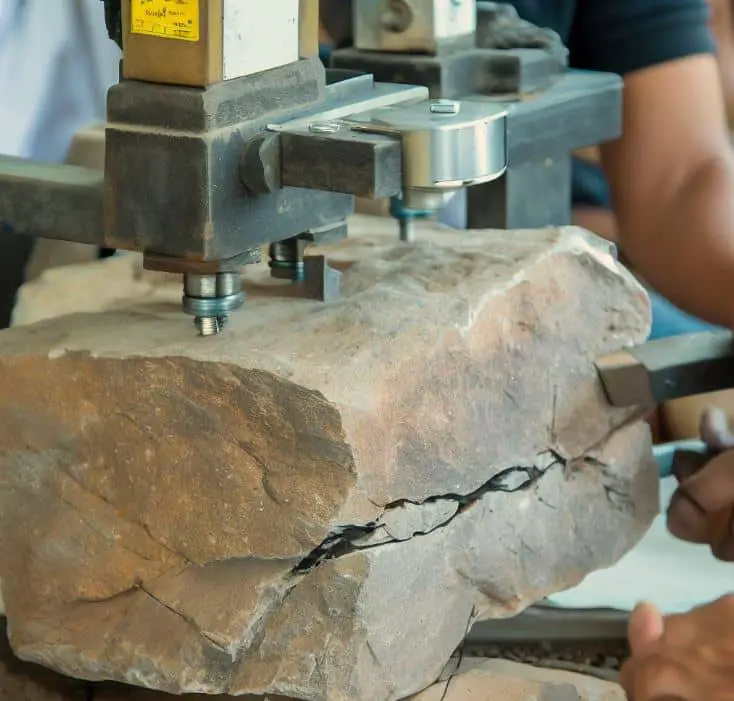
To ensure the safety and stability of rock structures, rock strength testing plays a crucial role in the field of rock mechanics. This testing is essential for understanding the mechanical behavior of rocks under different loading conditions and for designing effective support systems.
Rock strength testing involves determining the strength and deformability properties of rocks through various laboratory and field tests. These tests provide valuable information about the rock’s ability to withstand external forces and resist failure.
Commonly used laboratory tests for rock strength evaluation include uniaxial compression, triaxial compression, and indirect tensile tests. These tests apply controlled loads to rock samples and measure the resulting stress-strain behavior. Field tests, such as the Schmidt hammer test and the point load test, provide quick and non-destructive methods to estimate rock strength.
By accurately assessing the strength properties of rocks, engineers can make informed decisions regarding the design and stability of rock slopes, tunnels, foundations, and other rock structures.
Stress Measurement and Analysis
Rock Mechanics is a branch of geotechnical engineering that deals with the behavior of rock materials under various conditions. One important aspect of rock mechanics is Stress Measurement and Analysis. Stress in rocks can have significant effects on their stability and behavior. Therefore, it is crucial to accurately measure and analyze the stress distribution within a rock mass.
Stress measurement techniques in rock mechanics include hydraulic fracturing, overcoring, and borehole stress cells. Hydraulic fracturing involves injecting fluid into a borehole to induce fractures, from which the stress can be determined. Overcoring involves extracting a cylindrical core sample from a rock mass and measuring the stress through strain gauge measurements. Borehole stress cells are installed in boreholes and directly measure the stress experienced by the surrounding rock.
Stress analysis in rock mechanics relies on various numerical and analytical methods. The finite element method (FEM) is commonly used to model the stress distribution in complex rock masses.
Geochemistry
Geochemistry is a scientific discipline that encompasses various subtopics such as Mineralogy and Petrology, Geochemical Analysis, Diagnostic Techniques, Biogeochemistry, and Geochemical databases. Mineralogy and Petrology focus on the study of minerals and rocks, their composition, structure, and formation processes. Geochemical Analysis involves the measurement and interpretation of chemical elements and isotopes in rocks, minerals, and fluids. Diagnostic Techniques are used to identify and characterize geological materials based on their physical and chemical properties. Biogeochemistry studies the chemical cycles and processes that occur in the environment involving living organisms.
Mineralogy and Petrology
After studying the mechanics of rocks, we now turn our attention to the fascinating field of geochemistry. Mineralogy and petrology are crucial aspects of geochemistry, as they involve the study of minerals and rocks, their composition, and their formation processes.
Mineralogy focuses on the identification and classification of minerals, their crystal structures, and their physical and chemical properties. Understanding the mineral composition of rocks provides valuable insights into their origins and geological history. Petrology, on the other hand, delves deeper into the study of rocks, examining their texture, structure, and the processes that formed them. This field is essential for understanding the evolution of the Earth’s crust and the formation of different rock types.
Geochemical analysis plays a crucial role in mineralogy and petrology. It involves the quantitative analysis of elements and isotopes in minerals and rocks. Through various analytical techniques, such as X-ray fluorescence and mass spectrometry, scientists can determine the major and trace element composition of minerals, providing valuable information about their formation conditions.
Geochemical Analysis

With a solid understanding of rock mechanics, the next step in studying the Earth’s composition is through geochemical analysis. This branch of geology focuses on the chemical composition and behavior of minerals, rocks, and fluids. Geochemical analysis plays a crucial role in determining the origin, evolution, and geological history of various geological materials.
Mineralogy and Petrology form the foundation of geochemical analysis. Mineralogists identify and classify minerals based on their chemical composition and crystal structure, while petrologists study the formation and characteristics of rocks. By analyzing the elemental and isotopic composition of minerals and rocks, geochemists gain insights into the geological processes occurring within the Earth’s crust and mantle.
Diagnostic techniques are employed to extract and analyze geochemical samples. These techniques include X-ray fluorescence (XRF), inductively coupled plasma mass spectrometry (ICP-MS), and electron microprobe analysis.
Diagnostic Techniques
To better understand the geochemical composition of rocks, various diagnostic techniques are utilized. These techniques allow scientists to identify and analyze the mineralogical and petrological properties of rocks, providing valuable insights into their formation and evolution.
X-ray diffraction is a commonly used diagnostic technique that determines the crystal structure and mineral content of a rock sample by analyzing the diffraction patterns produced by X-ray beams. This technique allows researchers to identify the minerals present in rock and their relative abundance.
Another important diagnostic technique is electron microprobe analysis, which uses a focused electron beam to generate X-rays from a small area of a sample. This analysis can provide detailed information about the chemical composition of individual minerals within a rock.
Laser ablation inductively coupled plasma mass spectrometry (LA-ICP-MS) is a powerful technique that allows for the precise analysis of trace elements in rocks.
Geomorphology
Landscape evolution is a fundamental aspect of geomorphology, which encompasses the study of landforms and processes that shape the Earth’s surface. Process geomorphology focuses on the understanding of the various mechanisms that drive landscape change. Sedimentology and stratigraphy investigate the deposition and formation of sedimentary rocks, providing insights into past environments and geologic history. Fluvial processes explore the dynamics of rivers and streams, including erosion, transportation, and deposition of sediment. Coastal processes encompass the study of coastal landforms, such as beaches, dunes, and cliffs, as well as the processes that shape them, such as waves, tides, and currents.
Landscape Evolution

Geomorphology is the study of the physical features of the Earth’s surface and the processes that shape them. One of the main areas of focus within geomorphology is the landscape evolution of different regions. Landscape evolution refers to the changes that occur in the landforms and land surfaces over time due to various geological and environmental factors.
Process geomorphology is a subfield of geomorphology that seeks to understand the processes that shape the Earth’s surface. This includes studying the effects of weathering, erosion, and deposition on the landscape. By examining these processes, scientists can gain a better understanding of how different landforms are formed and how they change over time.
Another important aspect of landscape evolution is sedimentology and stratigraphy. Sedimentology is the study of sediment and its properties, while stratigraphy focuses on the layers of sediment and rock that make up the Earth’s crust. By studying sedimentology and stratigraphy, scientists can reconstruct the history of a particular landscape and understand the processes that have shaped it.
Process Geomorphology
Geomorphology is the study of the Earth’s surface and the processes that shape it. Process Geomorphology is a subfield within geomorphology that focuses on understanding the underlying processes that drive landscape evolution.
In process geomorphology, researchers investigate the various forces that shape the Earth’s surface, such as weathering, erosion, and deposition. By studying these processes, scientists can gain insights into how landscapes form and change over time. For example, they may analyze the impact of water flow on landforms or the effects of wind erosion on desert landscapes.
Understanding process geomorphology is crucial for a variety of applications. It can help predict and mitigate the effects of natural hazards, such as landslides or flooding. It also plays a role in resource management, as knowledge of landscape evolution can inform decisions about land use and conservation.
Sedimentology and Stratigraphy
Geomorphology is the study of the Earth’s landforms and the processes that shape them. Sedimentology and Stratigraphy is a subfield of geomorphology that focuses on the study of sedimentary rocks and the layers of sediment within them. Sedimentology involves examining the composition, texture, and structure of sediments, while stratigraphy focuses on the arrangement and sequence of these sedimentary layers.
Understanding sedimentology and stratigraphy is crucial for reconstructing past environments and interpreting Earth’s history. By analyzing the types of sediment and their distribution, scientists can infer the processes that shaped a landscape and the conditions at the time of deposition. For example, studying the layers of sediment in a delta can provide insights into the changing courses of rivers over time.
Furthermore, sedimentology and stratigraphy play a vital role in identifying and characterizing natural resources such as oil, gas, and groundwater. By examining the composition and arrangement of sedimentary layers, geologists can determine the potential for the presence of these valuable resources.
In conclusion, geological engineering branches encompass a wide range of disciplines that contribute to the understanding and management of Earth’s resources and environment. Geotechnical Engineering focuses on the behavior of soil and rock and its application in designing foundations, slopes, and retaining structures. Environmental Geology addresses the impact of human activities on the environment and seeks to find sustainable solutions to mitigate these effects. Geophysics utilizes various techniques to study the physical properties of Earth and is crucial in locating and assessing mineral and energy resources.
Mining Engineering involves the extraction of valuable minerals from the Earth while ensuring the safety of workers and minimizing environmental impact. Structural Geology studies the deformation of rocks and their relevance to engineering projects such as tunneling and underground construction. Petroleum Engineering focuses on the extraction and production of oil and gas resources. Coastal Engineering deals with the design and management of coastal areas, protecting them from erosion and flooding. Rock Mechanics involves the study of the mechanical behavior of rocks and their application in tunneling and underground excavations. Geochemistry examines the chemical composition and reactions of rocks, soils, and water, providing valuable insights into geological processes.

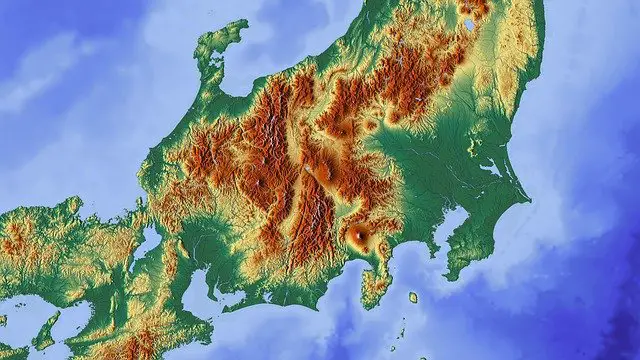
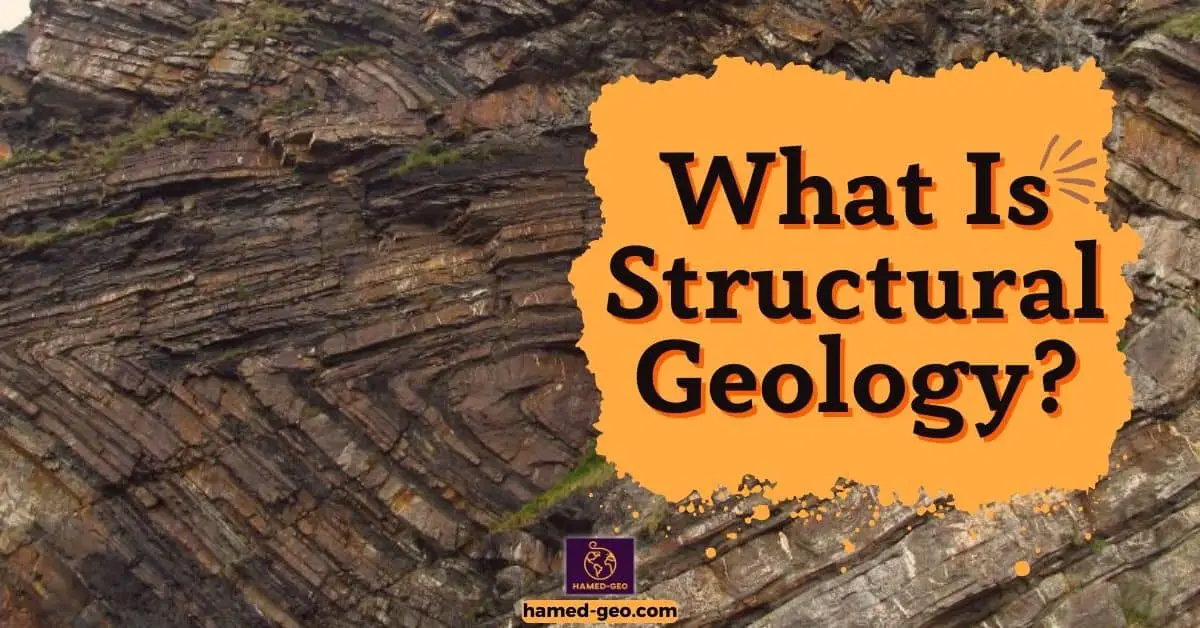
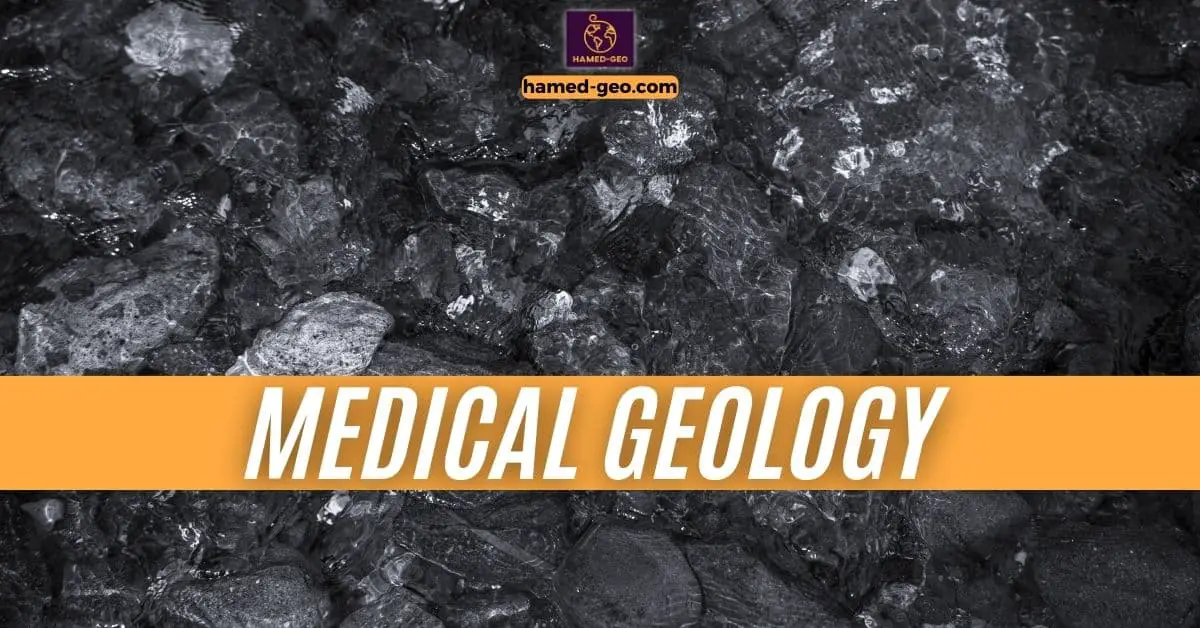
[…] Geological engineering is an interdisciplinary field that combines geology, physics, chemistry, mathematics, and engineering. It is a field that requires a broad knowledge of natural sciences and engineering principles to solve complex problems related to the Earth’s surface. Geological engineers work with geologists, hydrologists, environmental scientists, and other professionals to design and build structures interact with the Earth’s surface. […]